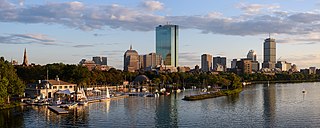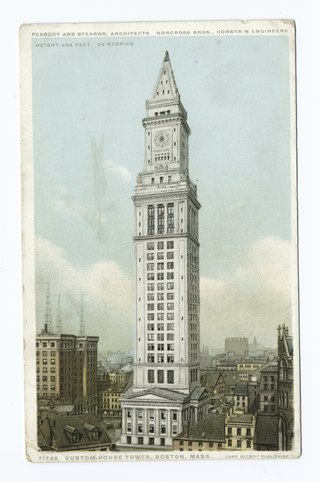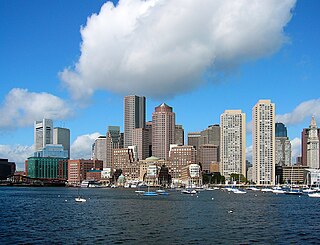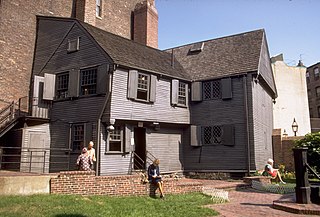
The John Hancock Tower, colloquially known as the Hancock, is a 60-story, 790-foot (240 m) skyscraper in the Back Bay neighborhood of downtown Boston, Massachusetts. The pinnacle height is 852-foot (260 m). Designed by Henry N. Cobb of the firm I. M. Pei & Partners, it was completed in 1976, and has held the title as the tallest building in New England ever since. In 2015, the lease belonging to the John Hancock Mutual Life Insurance Company, for which the skyscraper was named, expired, and it was renamed to its address at 200 Clarendon Street.

Back Bay is an officially recognized neighborhood of Boston, Massachusetts, built on reclaimed land in the Charles River basin. Construction began in 1859, as the demand for luxury housing exceeded the availability in the city at the time, and the area was fully built by around 1900. It is most famous for its rows of Victorian brownstone homes—considered one of the best preserved examples of 19th-century urban design in the United States—as well as numerous architecturally significant individual buildings, and cultural institutions such as the Boston Public Library, and Boston Architectural College. Initially conceived as a residential-only area, commercial buildings were permitted from around 1890, and Back Bay now features many office buildings, including the John Hancock Tower, Boston's tallest skyscraper. It is also considered a fashionable shopping destination and home to several major hotels.
FleetBoston Financial was a Boston, Massachusetts–based bank created in 1999 by the merger of Fleet Financial Group and BankBoston. In 2004 it merged with Bank of America; all of its banks and branches were converted to Bank of America.

Copley Square is a public square in Boston's Back Bay neighborhood, bounded by Boylston Street, Clarendon Street, St. James Avenue, and Dartmouth Street. The square is named for painter John Singleton Copley. Prior to 1883 it was known as Art Square due to its many cultural institutions, some of which remain today.

BankBoston was a bank based in Boston, Massachusetts, which was created by the 1996 merger of Bank of Boston and BayBank. One of its predecessor banks started in 1784, but the merged BankBoston was short-lived, being acquired by FleetBoston Financial in 1999. In 2005, FleetBoston was purchased by, and merged into, Bank of America of Charlotte, North Carolina.

The Prudential Tower, also known as the Prudential Building or, colloquially, the Pru, is an international style skyscraper in Boston, Massachusetts. The building, a part of the Prudential Center complex, currently stands as the 2nd-tallest building in Boston, behind the John Hancock Tower. The Prudential Tower was designed by Charles Luckman and Associates for Prudential Insurance. Completed in 1964, the building is 749 feet (228 m) tall, with 52 floors, and is tied with others as the 114th-tallest in the United States. It contains 1.2 million sq ft (110,000 m2) of commercial and retail space. Including its radio mast, the tower's pinnacle height reaches 907 feet (276 m).

The Custom House Tower is a skyscraper in McKinley Square, in the Financial District neighborhood of Boston, Massachusetts. The original building was constructed in 1837–47 and was designed by Ammi Burnham Young in the Greek Revival style. The tower was designed by Peabody and Stearns and was added in 1913–15. The building is part of the Custom House District, which was added to the National Register of Historic Places in 1973.

One Federal Street is a skyscraper in the Financial District neighborhood of Boston, Massachusetts. Completed in 1975, it is Boston's 15th-tallest building, standing 520 feet tall, and housing 38 floors. It is very close to the Rose F. Kennedy Greenway, Faneuil Hall Marketplace. Construction of the building was completed in 1976. However, it underwent renovations between 1992 and 2011. Some of the most notable tenants include: AON Service Corporation, Morgan Lewis & Bockius LLP, Credit Suisse, J.P. Morgan, Oppenheimer, and U.S. Bank.

The Financial District of Boston is located in Downtown Boston, near Government Center and Chinatown.

John Hancock Life Insurance Company, U.S.A. is a Boston-based insurance company. Established April 21, 1862, it was named in honor of John Hancock, a prominent American Patriot.

Manulife Financial Corporation is a Canadian multinational insurance company and financial services provider headquartered in Toronto, Ontario. The company operates in Canada and Asia as "Manulife" and in the United States primarily through its John Hancock Financial division. As of December 2021, the company employed approximately 38,000 people and had 119,000 agents under contract, and has CA$1.4 trillion in assets under management and administration. Manulife at one point serviced over 26 million customers worldwide.
Henry Nichols Cobb was an American architect and founding partner with I.M. Pei and Eason H. Leonard of Pei Cobb Freed & Partners, an international architectural firm based in New York City.

1801 Hollis Street is an office building in downtown Halifax, Nova Scotia, Canada. Completed in 1985, it is one of the tallest buildings in Halifax, at 87 metres, with 22 floors. It was built as the corporate headquarters of Central Trust, one of the largest trust companies in Canada in the 1980s, and was originally known as Central Trust Tower.

The Industrial National Bank Building, located at 111 Westminster Street or 55 Kennedy Plaza in downtown Providence, Rhode Island, was built in 1928 as the Industrial Trust Co. Building, and was designed by the New York firm of Walker & Gillette. At 428 feet (130 m) with 26 floors, it is the tallest building in Providence and the state of Rhode Island, and the 28th tallest in New England; when it was completed it stood several stories higher than the recently finished Biltmore Hotel nearby.

Market Center, formerly known as the Standard Oil Buildings and later the Chevron Towers, is a complex comprising two skyscrapers at 555–575 Market Street in the Financial District of downtown San Francisco, California. It served as the headquarters of the Chevron Corporation until 2001. As of 2019, it is owned by Paramount Group, Inc.
J. Harleston Parker was an American architect active in Boston, Massachusetts.

One Dalton is a 850,000 sq ft (79,000 m2) skyscraper in Boston, Massachusetts. Also referred to as the Hudson Tower, it is the third tallest building in Boston, the tallest residential building in New England, and the tallest building constructed in the city since Hancock Place in 1976. It is located in the Back Bay neighborhood, not far from 200 Clarendon Street and the Prudential Tower, the two tallest skyscrapers in Boston. It contains the Four Seasons Hotel & Private Residences, One Dalton Street.
Joseph E. O'Connell Sr. was an American businessman and racehorse owner. Two of his horses, Cavan and Celtic Ash, won the Belmont Stakes.

The architecture of Boston is a robust combination of old and new architecture. As one of the oldest cities in North America, Boston, Massachusetts has accumulated buildings and structures ranging from the 17th-century to the present day, having evolved from a small port town to a large cosmopolitan center for education, industry, finance, and technology. The city is known for its granite buildings stemming from its early days. It is also known for being one of the origins of Federal Architecture.

















